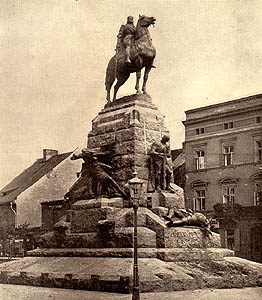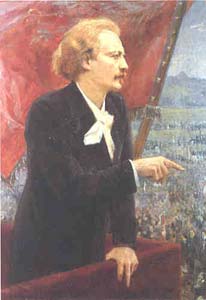
Grunwald: A monument to hearten spirits
 The Grunwald Monument 1910, by Antoni Wiwulski |
Erecting such a monument commemorating the battle had been a dream of Paderewski who described it in the following terms: "At the age of 10, I read an account of the Battle of Grunwald that took place in 1410 during the war with the Teutonic Order. The battle was a great Polish victory. It came to my mind then that since 1910 will be the 500th anniversary of that victory it would be great if I could celebrate that victory by erecting a great monument." His feelings of patriotism had, no doubt, been impacted earlier when he witnessed Russian soldiers taking his father to prison for having helped insurgents during the January 1863 Uprising. Fortune had smiled upon him and his art, and his hugely popular recitals had made him a wealthy man. Yet, he always said "The Motherland first, art second." On the monument's plinth were inscribed the words "To the glory of our forefather 1410 - To our brothers to hearten their spirits 1910."
 Paderewski speaking at the unveiling of the monument 1910 postcard |
The composer Feliks Nowowiejski had composed an anthem for the occasion and now it was performed for the first time in public by massed choirs from all over the Polish lands. It was based on the text of a poem Maria Konopnicka had written in 1901 or 1902 (it wasn't published until 1908) at the height of the germanization campaign being carried in the Prussian partition and it expressed sentiments far stronger that Paderewski's speech. Nowakowski had called the anthem "Grunwald" but it was published under the title "Haslo" (Motto or Password). It later acquired the name Rota (The Oath) and, after Poland regained its independence and was deciding on a National Anthem, it was given serious consideration.
Krakow, once Poland's ancient Royal capital, was also one of the two principal cities in Galicia, the Austrian partition. Given a degree of home rule, Galicia was by far the most liberal of the three partitions. One manifestation of this was that, unlike the German and Russian partitions, the Polish language was not repressed in Galicia. Expression of patriotic feelings, such as might be aroused by the monument, was permitted. In this regard, the location of the monument had been carefully chosen. The ancient walled city was in the shape of an elongated teardrop with the Royal Castle and Cathedral on a its southern end overlooking the Vistula River. In ancient times, the City was surrounded by swamps and wetlands with the only good approach being from the north leading to the City's Florian Gate. Accordingly, the streets leading from the Florian Gate to the Wavel, the route Royalty would travel to the Wawel, Florianska to the Market Square and Grodska thereafter became the Royal Way. The monument located in Matejko square, just outside the Florian Gate, became the starting point of annual July 15th processions to the Wavel, commemorating the battle.
 Portrait of Paderewski by Jan Styka 1910, oil on canvas, National Museum, Poznan |
Paderewski, asked for the reasons behind his gesture said: "This monument, and no other, has to exist. That's required not by it alone, but also by this day of historic importance, the political moment, and the need to raise hearts with a visible symbol of the sacred past," The celebrations of the anniversary lasted three days. Among the events was a banquet Paderewski threw for various guests at the Grand Hotel. Francis Fronczak, Health Commissioner for the City of Buffalo, who was present at the unveiling and at the banquet in the Grand Hotel that followed, quoted Paderewski as having
 The Grunwald Monument 1976, in Marian Konieczny's recreation |
In the years that followed, a procession formed annually at the monument on July 15 and proceeded to the Wavel. More generally, after Poland regained its independence in 1918, the monument became the usual starting point of patriotic manifestation in Krakow, also serving as such for tours of Krakow's old town, a practice that continues to this day. Then came the German invasion of September 1939. Having occupied Poland, the Germans could not countenance the continued existence of the monument, both as a symbol of Polish national pride and a painful reminder to the Germans of a stunning defeat. By November, the Germans had surrounded the monument with a palisade of wooden planks hiding it from view. Demolition activities lasted till April 1940, the bronze being conveyed to foundries to be utilized for war equipment, the granite blocks being conveyed to distant sites. Poles made to work on the demolition managed to hide and save King Jagiello's scepter and sword, the coats of arms of Poland, Lithuania and Żmudź (entity corresponding approximately to the current territory of Lithuania), and the head of Grand Duke Witold. With the end of the conflict in 1945 the notion became firm among the citizens of Krakow that the monument must be rebuilt.
It wasn't until 1972 that the reconstruction project got underway. The job was entrusted to sculptor Marian Konieczny, then the Rector of the Academy of Fine Arts in Krakow. Unfortunately, the forms used in casting the bronze effigies were no longer in existence. Accordingly, the effigies had to be recreated. Fortunately, one of Wikulski's assistants, Franciszek Ksawery Black, had left behind to his daughter, Maya Black, a plaster model of the monument and portafolio of sketches and documentations of the original monument. Now, Konieczny and Prof. Wiktor Zin journed to Paris from where following negotiations with Ms. Black, they were able to bring these artifacts back to Krakow. According to Konieczny, the original figures included a lot of fine detail, detail which he omitted making the figures more monumental. He also turned the head of the King slightly to the right and that of the horse slightly to the left. The reconstructed monument was eventually assembled in 1976 and ceremoniously unveiled on October 16 of that year.
Notes:
1. A loyal Buffalonian, by Stanislaw Dabrowski, Unpublished manuscript, p 201, (1980)
This page may include copyrighted material, and is to be used for educational and research purposes only.
| Info-Poland a clearinghouse of information about Poland, Polish Universities, Polish Studies, etc. |